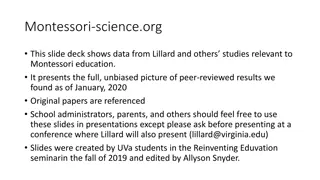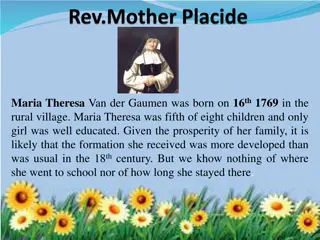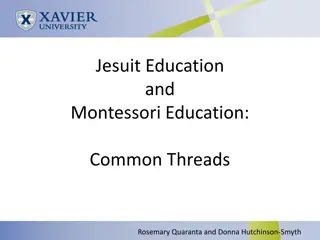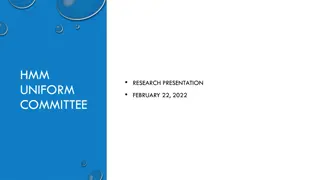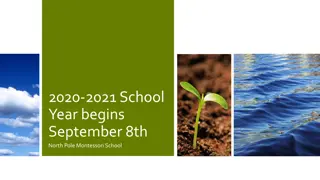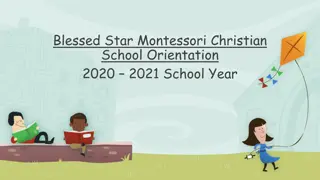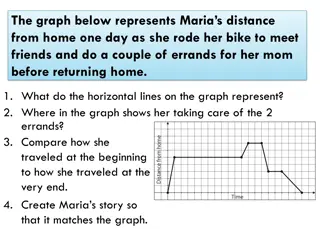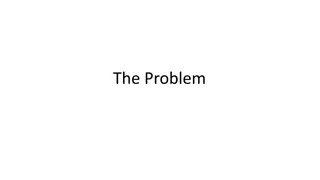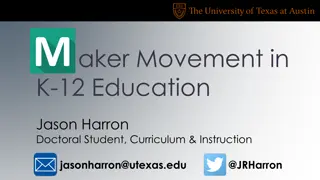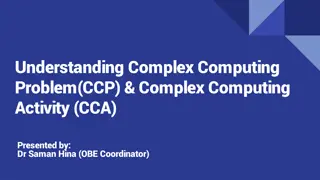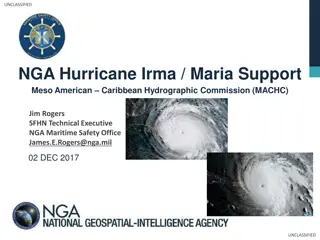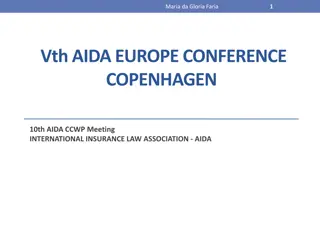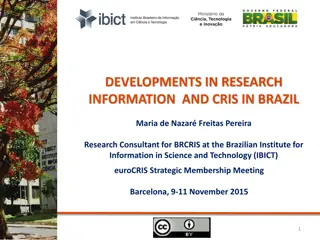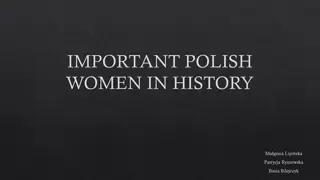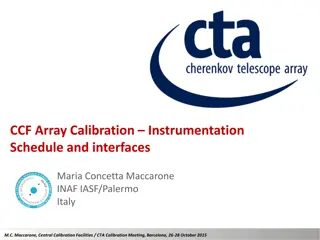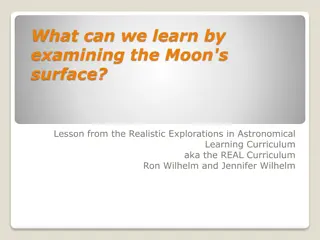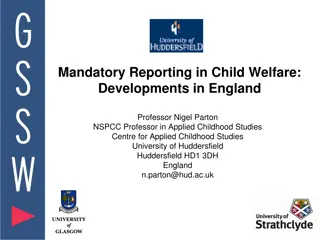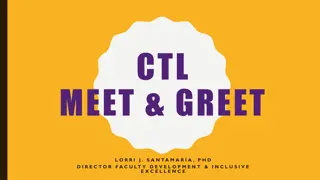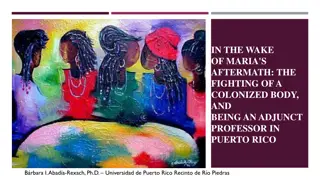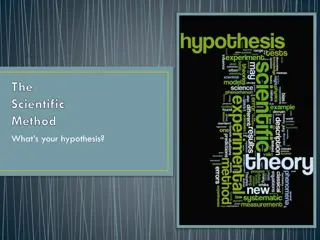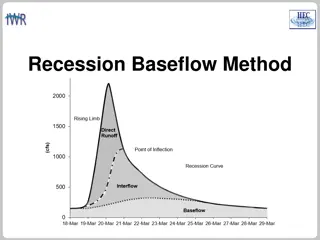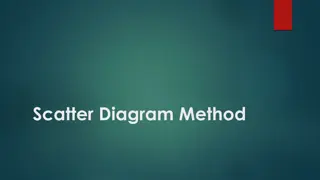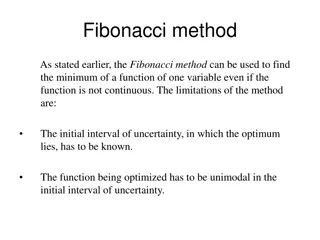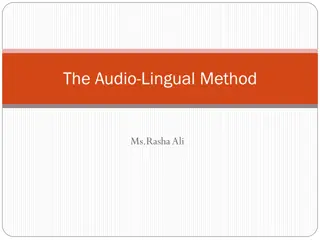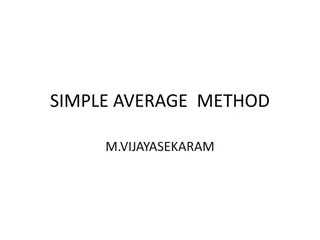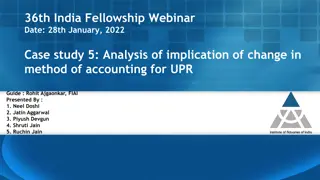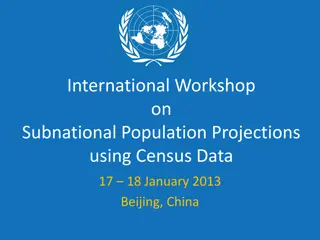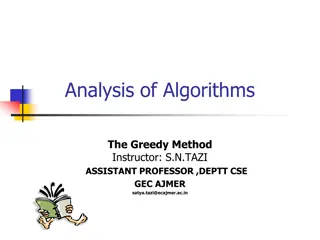Understanding the Montessori Method and Maria Montessori
The Montessori Method, developed by Maria Montessori, focuses on allowing children to learn at their own pace and respecting their individuality. Maria Montessori was an Italian educator who believed in the potential of children and their innate drive to learn. She established the first Casa dei Bambini and introduced principles like respect for the child, the absorbent mind, and sensitive periods. Her work continues to influence education worldwide.
Download Presentation

Please find below an Image/Link to download the presentation.
The content on the website is provided AS IS for your information and personal use only. It may not be sold, licensed, or shared on other websites without obtaining consent from the author. Download presentation by click this link. If you encounter any issues during the download, it is possible that the publisher has removed the file from their server.
E N D
Presentation Transcript
The Montessori Method Fabrizio Boldrini Director Fondazione Hallgarten Franchetti Centro Studi Villa Montesca
Maria Montessori, (born August 31, 1870, Chiaravalle, near Ancona, Italydied May 6, 1952, Noordwijk aan Zee, Netherlands) Italian educator and originator of the educational system that bears her name. The Montessori system is based on belief in the creative potential of children, their drive to learn, and the right of each child to be treated as an individual. After graduating in medicine from the University of Rome in 1896 the first woman in Italy to do so Montessori was appointed assistant doctor at the psychiatric clinic of the University of Rome, where she became interested in the educational problems of intellectually disabled children. Between 1899 and 1901 she served as director of the State Orthophrenic School of Rome, where her methods proved extremely successful. From 1896 to 1906 she held a chair in hygiene at a women s college in Rome, and from 1900 to 1907 she lectured in pedagogy at the University of Rome, holding a chair in anthropology from 1904 to 1908. During these years she continued her studies of philosophy, psychology, and education. In 1907 Montessori opened the first Casa dei Bambini ( Children sHouse ), a preschool for children age three to six from the San Lorenzo slum district of Rome, applying her methods now to children of normal intelligence. Her successes led to the opening of other Montessori schools, and for the next 40 years she traveled throughout Europe, India, and the United States lecturing, writing, and establishing teacher-training programs. In 1922 she was appointed government inspector of schools in Italy, but left the country in 1934 because of the Fascist rule. After periods in Spain and Ceylon (now Sri Lanka), she settled in the Netherlands.
Respect for the child Teachers show respect for children when they help them do things and learn for themselves. When children have choices, they are able to develop the skills and abilities necessary for effective learning autonomy and positive self-esteem.
The absorbent mind Montessori believed that children educate themselves: It may be said that we acquire knowledge by using our minds; but the child absorbs knowledge directly into his psychic life. Simply by continuing to live, the child learns to speak his native tongue (Montessori, 1966).
Sensitive periods A sensitive period refers to a special sensibility which a child acquires in its infantile state, while it is still in a process of initial rapid growth. It is a transient disposition and refers to acquisition of a particular trait. Once this trait or characteristic has been acquired, the special sensibility disappears.
The prepared environment The prepared environment makes learning materials and experiences available to children in an orderly format. Freedom is the essential characteristic of the prepared environment. Since children within the environment are free to explore materials of their own choosing, they absorb what they find there.
Autoeducation Montessori named the concept that children are capable of educating themselves autoeducation (also known as self-education). Children who are actively involved in a prepared environment and who exercise freedom of choice literally educate themselves. Montessori teachers prepare classrooms so that children educate themselves.
The Baby! A Genius Not only are babies brains structurally quite different from those of adults, but they also function in a way that makes them better than adults at learning new things. In other words, babies seem to be specially designed for exploration and finding out how things work. They re little scientists at least, that is, until those exploratory habits get replaced over time by less flexible thinking styles. Babies have many, many more neural connections being formed, many more synapses being formed, than we adults do (Alison Gopnik).
Application of the Montessori principle to critical target groups MBS - My Beautiful School, a place where it is possibile to be happy and experience with Roma children
MBS - My Beautiful School, a place where it is possible to be happy The pedagogic scheme was divided in 3 areas related to the development of the personal and social independence of the children. According to the approach we need to create a proper learning environment in order to facilitate the children to feel free to express themselves. This scheme can try to answer the question: How can we, in practice, facilitate this environment for the Roma children ?
PEDAGOGIC MAIN POINTS OF REFERENCE Roma Children are used to learn in an informal and not-formal way Schools have to take into account this perspective involving in the learning path not merely the time of school but the whole social context. For this reason it is very strategic to involve the Roma Parents in this effort.
The Roma tradition is diffident toward the institutions. Roma are convinced that the formal education cannot help the children to keep their tradition alive Learning memories can be used to support the culture of the school life, by helping the children to remember what they have done before and plan what they will do next (Azouaou and al, 2003). They can also be used to store personal resources potentially useful for the entire class. Children might be invited to tell the stories of their families to give to the other evidence of their own stories. The personal and familiar stories could also be facilitated by the presence of Roma parents.
Roma children in some cases are not used to assure a stable presence in school or they are used to change It could be useful for the teachers involved in the Roma education tracing the previous learners activity. The problem of tracing the activity is also taken into account by the European debate on Long Life Learning. It can also help to facilitate the activity of learners. Some authors consider interactions traces as potential sources for facilitating self-understanding of both environment and lessons. Appropriation is seen as linked to the vygotskian process of self-development. We can argue that the appropriation of self generated content and contexts by children and young people offers impulses for their personal development.
Roma children could consider the knowledge proposed by the School as extraneous According to the Vygotsky idea of property of learning we can take advantage of the presence of Roma children in class in order to increase the creation of new knowledge. We need to support the contribution of Roma children to the creation of contents. It can help to feel the education process more interesting and next. A way can be represented by the strong influence of students verbal contribution can have on the self-directed learning during the daily proposition of contents.
Creating a learning and teaching style addressed to promote a better Knowledge of the Roma cultures and traditions It is possible to involve the parental context of the Roma children also in order to have more information and to develop knowledge about the cultures and tradition of Roma people. This idea is based on principle that are in theory considered very common, but whose practice is not always taken into account in the daily school activity.
Teaching (and encouraging) diversity Embracing the principles of diversity taught in school requires everybody to put diversity into practice. That means reworking lesson plans, encouraging new, more diverse student activities, inviting 'different' teachers (for instance Roma teachers to present their traditions). Communication imparts knowledge which can breed understanding. We cannot embrace diversity by remaining set in our ways, beliefs and thoughts. Creating a climate of diversity means radically altering the way your school does things.
Educative consequences This approach implies the following didactic actions: Freedom and spontaneity, including increasing the social competences Creativity and Problem solving
Thank you for your kind attention! Fabrizio Boldrini Director Fondazione Hallgarten Franchetti Centro Studi Villa Montesca



